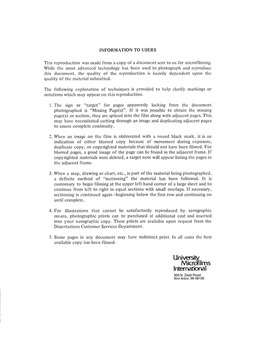| dc.contributor.author | Guinn, Marcia Ann Fitzgerald, | en_US |
| dc.date.accessioned | 2013-08-16T12:29:18Z | |
| dc.date.available | 2013-08-16T12:29:18Z | |
| dc.date.issued | 1984 | en_US |
| dc.identifier.uri | https://hdl.handle.net/11244/5306 | |
| dc.description.abstract | Hypotheses were tested with regard to differences in: (1) source of influence (2) gender (3) race (4) childcare setting (5) gender typed toy preference. Secondary differences were observed in the study by visually comparing toy preferences that were salient. | en_US |
| dc.description.abstract | The purpose of this study was to determine significant basic influences on gender typed toy preferences of Native American and non-Native American children in day care/non-day care settings. | en_US |
| dc.description.abstract | The results of testing the ten hypotheses showed that there was a significant difference in male and female toy preferences with regard to sources of influence. There was no significant difference in sources of influence on Native American and non-Native American children's gender typed toy preferences. There was a significant difference in sources of influence on gender toy preferences in a day care/non-day care setting. There was a significant difference between sources of influence on toy selection and toy preferences with regard to male, female, and neutral toys. There was no significant difference in the gender typed toy preferences of male and female Native American and non-Native American children. There was no significant difference in the Native American and non-Native American child's toy preferences in a day care/non-day care setting. There was no significant difference in the Native American child's male, female and neutral gender typed toy preferences. There was no significant difference in male and female children's toy preferences in a day care/non-day care setting. A significant difference in male and female responses in gender typed toy preferences was found but there was no significant difference in gender typed toy preferences of children in a day care/non-day care setting. | en_US |
| dc.description.abstract | Subjects were one hundred and fifty five three and four year old children of Native American and non-Native American descent in day care/non-day care settings. Sixty six males and sixty-nine females were presented with black and white photographs of male, female and neutral toys classified as such by a panel of experts in Special Education and Early Childhood Education. Additional information was acquired by interviewing each child following the procedure for indicating their toy preferences. | en_US |
| dc.format.extent | vi, 91 leaves, [9] leaves of plates : | en_US |
| dc.subject | Education, Early Childhood. | en_US |
| dc.title | Gender type toy preferences of Native American, non-Native American preschool children in day care, non-day care settings / | en_US |
| dc.type | Thesis | en_US |
| dc.thesis.degree | Educat.D. | en_US |
| dc.thesis.degreeDiscipline | Jeannine Rainbolt College of Education | en_US |
| dc.note | Source: Dissertation Abstracts International, Volume: 45-12, Section: A, page: 3541. | en_US |
| ou.identifier | (UMI)AAI8504322 | en_US |
| ou.group | Jeannine Rainbolt College of Education | |
